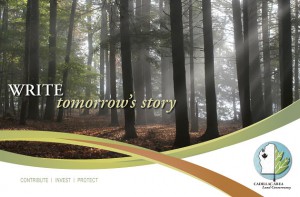The Rensberry Property in the Wildlife Corridor of Wexford County
In the fall of 1986 I purchased 360 acres in Cherry Grove Township of Wexford County. I purchased it so I would have a place to hunt deer, turkey, birds, and other big game animals that are hunted in Michigan. Almost immediately I built a log hunting camp, pole barn, and began reinforcing fencing and doing some plantings in and around the log cabin.
The property was very unique, in that the headwaters of the Pine River ran almost it’s full length. There was a 5-1/2 acre lake just below where I built the log cabin. There was several small streams running different directions throughout the property, as well as large wetlands which included bogs and a tamarack, cedar, hemlock swamp on both sides of the Pine River. It had high, rolling ridges, with some good soil for cultivation.
The more I explored the property, the more I fell in love with it. I began to farm smaller food plots throughout the property. I farmed for the sole purpose of soil conservation (by rotating the crops 3 times a year) and to feed the wildlife such as turkey, deer, local birds and migratory birds. I had a 10 year stewardship plan prepared, which I have followed religiously. The lake was treated for stunted fish and I have replanted several different species of fish there. As part of the stewardship requirements I had my plan updated by a professional consultant in 2007 for future management goals.
Over time new housing developments sprang up along my south and west wire. Homes were popping up all over the area around me where family farms had been. I began to realize that my property was vulnerable to development to the banks of the Pine River.
While I had no intention of selling my property to anyone much less a developer, I knew that someday this property could go on the market and that it could be fragmented. In light of that, I decided to investigate the possibility of putting my property into a conservation easement because I loved it so much. This led me to help establish the Cadillac Area Land Conservancy for our surrounding four counties. I loved my land and never wanted to see it destroyed or divided. I had so much time, money, and energy in the property that I wanted to preserve it for as long as possible in its natural state. A conservation easement was really the only way to do it quickly, economically, and permanently.
— Tom Rensberry
The Lawless Property on Sanborn Creek in Lake Co.
“When our family moved from Lake County, Michigan, in 1963, we had enjoyed over seven years of fishing, hunting, canoeing, boating and hiking in the beautiful environment. It was our vow that if the opportunity presented itself, we would go back to preserve as much of this land, water, wildlife and natural beauty as possible.
That vow began to evolve in 1968 when we went back and purchased a lot on the Sanborn Creek. Subsequently, a cabin was built and we began acquiring adjacent property along the stream. By 2002 a total of 153 acres had been purchased.
Working with the Cadillac Area Land Conservancy (CALC), a conservation easement was placed on 134.5 acres in November 2005. The cooperation and help from the Cadillac Area Land Conservancy made this possible.
Now we take great satisfaction and joy in knowing this pristine property and stream will be maintained and protected in perpetuity. To those who have similar opportunity with their land, we strongly recommend giving a conservation easement serious consideration.
Beyond our family, we can think of few things better to leave this earth, than a piece of property that will be preserved for generations to come.”
— Fred and Pat Lawless
The Justus Easement in Osceola County near Tustin
Floyd and Denise Justus bought their 68 acre old farm in in northern Osceola Co. in 1995. It is a special place with a unique history. In 1892, John E Larson bought 68.7 acres in Sherman Twp. from the Grand Rapids and Indiana Railroad. Larson’s father, a Swedish immigrant, declared the land would never be productive due to the heavy soil. His son proved him wrong ! The farm produced hay, potatoes, pork , beef, fruit, honey, grain, and cream from a grade A dairy. The farm remained intact and in the family until the Justus’s bought it from Mr. Larson’s daughter, Louse Mott.
It was clear to Denise & Floyd that this piece of property had a story to tell. Because of the direct link to the immigration of Swedish families to the Tustin area in the 1870’s , and the willingness of Delores Norman Mr. Larson’s granddaughter, to share family history, the farm was given a special designation. On June 5, 1997 the old Larson Farm was added to the State Register of Historic Sites.
That spring Floyd & Denise watched a golf course being built across the road and knew that this historic farm could easily have become a driving range. They began to start searching for a way to protect the place after they are no longer reside there, A ‘chance’ encounter with a CALC newsletter, then a meeting with George & Vickie Rock, put them on the path of designing a conservation easement for their property. According to Denise Justus, former secretary for the Board of Directors of CALC, “It is the best thing we’ve ever done!”
— Floyd and Denise Justus
Larry and Margo Copley Donate Conservation Easement
We recently placed and easement on our 40-acre farm located in the Wildlife Corridor of Cherry Grove Township Wexford County. Our family has owned this property since 1932 and is currently still in agriculture.
We are committed to the land as it insures both solitude and sustenance not only for ourselves but our friends and neighbors both human and wildlife. Through our Conservation easement we are able to retain ownership of our land while insuring that future generations will have the same privilege.
The Cadillac Area Land Conservancy is an organization of dedicated volunteers to whom over the past several years have demonstrated that their goals of land preservation closely aligns with our philosophies.
Having placed an easement on our property we now feel secure that this home base is secure as we make daily forays into neighboring woodlands and byways of our community. Our land represents stability in an ever more cluttered and sub-divided landscape.
Our children appreciate our values, but are now in pursuit of their own lives. Recognizing these facts we also believe that large tracts of land will become more valuable in the future. Therefore, when we’re gone the sale of our property will provide for our children equitably, guarantee community aesthetics and effectively complete our legacy.
— Larry and Margo Copley
The Borak Forest and “Sugar Bush” Property in Wexford County
Robert and Julia Borak purchased their 129 ac. property in 1967 with a desire to manage the northern hardwoods and build that log cabin in the woods. The existing rundown buildings that were there then held images of past farming efforts on the open fields that were starting to be taken over by small trees and shrubs. In 1978 they tapped their hard maple trees and made their first 2 gallons of maple syrup on an open fire. Over time they built that log cabin, a “sugar shack”, where they now produce 50-70 gallons of maple syrup a year on an 8′ evaporator. In addition to a commercial sugar bush, the Borak’s have an active commercial forest with a Forest Management Plan. The 51 acres of Northern Hardwoods has had 2 selective harvests since 1978. The 36 acres of planted red and white pine have been thinned and will continue to be harvested for lumber production. The remaining acres of swamp conifer, aspen and open fields will be maintained for wildlife habitat. The family enjoys deer and small game hunting for recreation and wildlife viewing.
“The property has given us fun times, both work and play, for family and friends and I often think about how lucky we were to have had the opportunity to acquire this land and the energy and resources to manage it as we have done,” says Bob Borak. “As to the future of this land, it’s best use as I see it, is the management of the forest, and I have given the Cadillac Area Land Conservancy an Easement that will ensure future management plans.” Bob donated his Conservation Easement to CALC because he feels that far too many acres similar to his are being converted to uses other than forest management, and if this trend continues sustainable forest products from private lands will be lost. “If you feel as I do and have productive forest land that you want maintained to supply a sustainable forest product industry and other recreational uses, then a Conservation Easement with CALC may be something you mighty want to consider!”
— Bob Borak
Bob was a professional forester with the Michigan DNR for many years.
 124 ½ N Mitchell Suite 115
Cadillac, MI 49601
(231) 775-3631
124 ½ N Mitchell Suite 115
Cadillac, MI 49601
(231) 775-3631